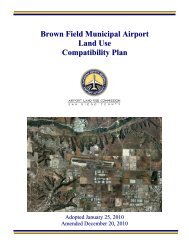Draft EA - San Diego International Airport
Draft EA - San Diego International Airport
Draft EA - San Diego International Airport
Create successful ePaper yourself
Turn your PDF publications into a flip-book with our unique Google optimized e-Paper software.
SAN DIEGO INTERNATIONAL AIRPORT – PROPOSED RUNWAY 9 DISPLACED THRESHOLD<br />
nonattainment but is in transition back to attainment. The CARB designates <strong>San</strong> <strong>Diego</strong> County as<br />
nonattainment for State CAAQS standards for the following criteria pollutants: ozone, particulate matter, and<br />
fine particulate matter. 17<br />
3.5.1.3 Greenhouse Gases and Climate Change<br />
The FAA released a memorandum in January 2012 providing guidance on the consideration and evaluation of<br />
greenhouse gases (GHGs) and climate under NEPA. 18<br />
The guidance supplements FAA Order 1050.1E to<br />
identify climate as a category of potential environmental impact that should be considered in <strong>EA</strong>s and EISs.<br />
According to most international reviews, aviation emissions comprise a small but potentially important<br />
percentage of anthropogenic (human-made) GHGs and other emissions that contribute to global warming.<br />
The Intergovernmental Panel on Climate Change (IPCC) estimates that global aircraft emissions account for<br />
about 3.5 percent of the total quantity of GHGs from human activities. 19<br />
In terms of U.S. contribution, the U.S.<br />
General Accounting Office (GAO) reports that aviation accounts “for about 3 percent of total U.S. greenhouse<br />
gas emissions from human sources” compared with other industrial sources, including the remainder of the<br />
transportation sector (23 percent) and industry (41 percent). 20<br />
The scientific community is developing areas of further study to enable them to more precisely estimate<br />
aviation's effects on the global atmosphere. The FAA is currently leading or participating in several efforts<br />
intended to clarify the role that commercial aviation plays in GHGs and climate change. The most<br />
comprehensive and multi-year program geared towards quantifying climate change effects of aviation is the<br />
Aviation Climate Change Research Initiative (ACCRI) funded by FAA and the National Aeronautics and Space<br />
Administration (NASA).<br />
The ACCRI will reduce key scientific uncertainties in quantifying aviation-related climate impacts and provide<br />
timely scientific input to inform policy-making decisions. FAA also funds Project 12 of the Partnership for Air<br />
Transportation Noise & Emissions Reduction (PARTNER) Center of Excellence research initiative to quantify the<br />
effects of aircraft exhaust and contrails on global and U.S. climate and atmospheric composition. Finally, the<br />
Transportation Research Board’s (TRB) <strong>Airport</strong> Cooperative Research Program (ACRP) Project 02-06 prepared<br />
a guidebook on preparing airport GHG emission inventories.<br />
17<br />
18<br />
19<br />
20<br />
California Air Resources Board, 2011 National Area Designations, http://www.arb.ca.gov/desig/adm/adm.htm, June 2011 (accessed: April<br />
9, 2013).<br />
U.S. Department of Transportation, Federal Aviation Administration, Order 1050.1E, Change 1, Guidance Memo #3, “Considering<br />
Greenhouse Gases and Climate Under the National Environmental Policy Act (NEPA): Interim Guidance.” To: FAA Lines of Business and<br />
Managers with NEPA Responsibilities. From: Julie Marks, Manager, Environmental Policy and Operations, prepared by Thomas W. Cuddy,<br />
January 12, 2012.<br />
IPCC Report as referenced in U.S. General Accounting Office (GAO) Environment: Aviation’s Effects on the Global Atmosphere Are<br />
Potentially Significant and Expected to Grow; GAO/RCED-00-57, February 2000, p. 4.<br />
Ibid, p. 14; GAO cites available EPA data from 1997.<br />
Affected Environment<br />
[3-18]<br />
<strong>Draft</strong> <strong>EA</strong>
















